HUMAN SERVICES COMMITTEE – NOVEMBER 13, 2018
THOMAS C. BUCKEL, JR., CHAIRMAN
MEMBERS PRESENT: Dr. Chase, Mr. Bush, Mr. Rowley
MEMBERS ABSENT: Mr. Jordan
ALSO ATTENDING: See attached list
Chairman Buckel called the meeting to order at 10:07 a.m. A motion was made by Mr. Rowley, seconded by Dr. Chase, to waive the reading of the proceedings from the previous committee. MOTION CARRIED. A motion was made by Mr. Rowley, seconded by Dr. Chase, to approve the minutes of the previous committee meeting. MOTION CARRIED.
1. DISCUSSION – Draft of Legislative Declaration to Reform Social Services Policies, Programs, and Delivery Processes
Chairman Buckel stated work items were not received from the administration therefore this is follow up of discussions he has had. The committee can either take the concept and run with it, drop it or defer to the administration.
Outline:
Concept for legislative declaration re poverty policy reform.
November 13, 2018
Whereas:
The city of Syracuse is one of the 10 poorest places in the United States, according to data released in September 2018 by the U.S. Census Bureau. Thirty three percent (33%) of the residents of Syracuse, or 48,000 people, currently live in poverty.
Poverty is not just an urban issue in Onondaga County. 14.6% of all residents in Onondaga County, or 68,000 people, currently live in poverty in Onondaga County. Eleven (11) school districts in Onondaga County serve student populations where 11% or more of their students live in poverty.
IRS data amplifies the income challenges and needs of Onondaga County residents. In 2016, 221,690 individual tax returns were filed by Onondaga County residents. 80,110 of those returns (36%) reported annual income of $25,000 or less. 132,760 returns (60%) reported annual income of$50,000 or less.
U.S. poverty programs and policies are subject to criticism from traditionally conservative and liberal perspectives. For instance, in October 2018, Onondaga County District Attorney William Fitzpatrick "blasted '50 years of misguided social programs' for continuing violence involving young people." Last year, the Washington Monthly featured an analysis finding that U.S. poverty policy is outdated and inefficient.
Last week, commentator David Brooks noted:
Similarly, for the last several decades American, welfare policy has focused on consumption-giving money to the poor so they can consume more. Yet we have not successfully helped poor people produce more so that they can take control of their own lives. We now spend more than $20,000 a year in means-tested government spending per person in poverty. And yet the average poverty rate for 2000 to 2015 was higher than it was for 1970 to 1985. D. Brooks, "What the Working Class is Trying to Tell Us," New York Times, November 8, 2018.
Onondaga County administers public benefit programs, including Temporary Assistance (traditional welfare programs) and the Supplemental Nutrition Assistance Program ("SNAP", traditionally known as "food stamps"). Currently, 13,816 county residents receive Temporary Assistance and 67,192 county residents receive SNAP.
While poverty programs and policies are largely governed by federal and state laws and regulations, the County, as the point of delivery for most programs and public benefits available to its residents, is uniquely positioned to innovate and modernize the manner in which it delivers social services innovate and bolster efforts by low-income county residents to rise out of poverty.
The new County Executive of Onondaga County, Ryan McMahon, stated that addressing poverty and creating opportunity is one of his first priorities.
The Human Services Committee is resolved to enact a reformed program delivery and anti-poverty program that helps individuals and families escape poverty, boosts long-term independence for people now living in poverty, and slashes government bureaucracy and expenses.
Modem technology provides the county with tools to increase access to public and private benefit programs, while shifting massive resources from day to day public benefit case management, to active engagement with individuals and families in need to help build action plans to lift themselves out of poverty in the long term.
Through this resolution, the [Human Services Committee of the Onondaga County Legislature] or [County Legislature] presents a policy framework to collaborate with the County Executive to restructure county social services delivery infrastructure to cut bureaucracy costs and help individuals and families rise out of poverty.
Accordingly......
1. The legislature declares it the policy of Onondaga County to develop a pilot program to modernize and reform poverty programs in ways that are efficient and reach every county resident in need, while at the same time encouraging personal responsibility and reducing dependence on public benefit programs.
2. The legislature requests the administration to investigate necessary processes, procedures and federal/state waivers or approvals, to equip all county low-income residents receiving benefits, and others meeting low income criteria to be developed, with an Online HOPE (Health, Opportunity, and Personal Empowerment) account.
3. HOPE accounts would combine improved technology, streamlined case management, and coordinated access to multiple to federal, state, city, and nonprofit programs that exist for Onondaga County residents.
4. All HOPE accounts would be part of a process whereby public benefit recipients, and others meeting defined income criteria, develop an action plan that can help individuals both receive the benefits they need and build a long-term plan to lift themselves out of poverty in the long term. These action plans should not only seek to provide as much public and private aid to each family as possible,
they should also specify exactly how all parties will work together to help the families earn, learn, and save better in order to ensure greater economic opportunity for themselves and their children.
5. The legislature believes that the county should form public/private partnerships with banks, credit unions, and technology companies to facilitate HOPE accounts and provide a foundation for stable banking and financial management relationships.
6. Once HOPE accounts and plans are in place, families should be able to use any smart phone, tablet, or computer to learn about the public benefit and private philanthropic programs for which they are eligible - including aid to improve health, nutrition, job training and placement, housing, income, etc. -and then apply for all of these programs at once from the convenience of their device. If supporting documents need to be submitted with the application, then families could take pictures of those documents and submit the pictures with the application. Such accounts, formed in conjunction with the public/private partnerships described above, would also be able to include any private savings that people are able to accrue.
7. For example, a single mother of two young children could voluntarily enter into a 10-year plan jointly with the county's social service department and with private philanthropies such as the local United Way or Salvation Army. The plan would include yearly benchmarks for how the mother would use increased resources provided to her family by the plan to boost her job skills, increase her earnings, improve the housing situation for her family, obtain more nutritious food, and begin to put money aside to help her children pay for college. Once the
specific goals are set, the specific actions each entity would be required to take in order for the mother to meet her goals -as well as the money and other resources that will need to be allocated for these actions from the family, the government, and the nonprofit partners -would all be spelled out in the plan.
8. The idea behind the action plans is to ensure that all the programs and people involved are working together in a long-term, positive relationship for the purpose of rising out of poverty, ensuing upward mobility and strengthening engaged citizenship.
9. Resources of the county in administering the program would be shifted from time-consuming, and expensive, day to day public benefits intake and assessment, to the creation and monitoring of action plans that, in the long run, should reduce administrative and benefit costs while reducing the numbers of county residents in poverty by successfully helping poor people produce more so that they can take control of their own lives.
Chairman Buckel:
-
Background –performed some poverty-related work for non-profits in private practice, was recruited to board chair for Legal Services of CNY, covering 13 counties, developed a deeper insight into how poverty programs are administered; surprised to learned how these programs affect our ability to deal with poverty populations and create independence
-
Hopes to create a legislative analysis and response to change poverty programs which the county has a hand in; wants to address passivity in the benefit process – rely on others to do the actual work, wants to find a way to make access to benefits and the complete array of assistance simple online, in tradeoff for banking financial relationships and a comprehensive assessment of the family, its needs, and its potential to be independent, includes income, benefits, education, children’s needs, medical needs and the development of a personal action plan for the family with specific goals
-
Action plans would be tailored and focused on individual initiative for responsible growth; will require application wavier from the federal government, hands are not tied, just a question of having the ambition to try something different that meets the needs of our community that has higher than normal poverty rates, hopes to have some sort of legislative process that works collaboratively with county government, county executive is open to something, remains to be seen if Social Service department is also; have seen traditional resistance with13 counties, followed federal law, didn’t want to rock the boat
-
Outline is a starting point open for discussion, if committee wants to go forward he in visions a legislative process different than the norm, collaboration with the county executive, possibly public hearings, input from local experts and engagement from the community at large with the goal of trying to do something by the end of the year or sooner if the executive desired
Mr. Rowley:
Chairman Buckel:
-
Fraud dominates many reactions to poverty programs, federal government requires counties to guard against fraud and they do it in different ways - expressed concerns for Onondaga County’s process, worked with Oneida County to revise and transform their program for management assessment of fraud, DSS staff are not fraud experts, requires a little more expertise, can be accomplished through data management with the right kind of programs – looking way down the line, that concern is always present
Mr. Rowley:
-
On a fundamental level questions where the persistence of poverty comes from in our area; not a robust area, economic activity is flat to declining depending on the year, established families with a cycle of poverty is some of it, also importing poverty from other areas due to our good benefit structure, available housing stock and the like, interested in the chairman’s perspective
Chairman Buckel:
-
Pushed back on the import issue - if that was the case Buffalo would be the same dynamic and Herkimer would be the lead; would love comprehensive data, encouraged all to review the states monthly reporting at https://otda.ny.gov/resources/caseload/, data does not drill down to age, race, origin but provides a starting point
-
For almost 20 years there has been a lifetime cap on traditional welfare benefits and the numbers reflect this - almost 14,000 county residents are on temporary assistance today versus 67,000 on SNAP, also consider the income of county residents (see pg. 1 IRS data) those numbers are very telling
-
New tax law provides enormous tax incentives for any kind of self-employment, using incentives to nurture individual enterprise may be the best way of attacking poverty populations here for whatever reason, i.e. education, medical, disability, huge component of mental illness
-
Tie component with an action plan, use job training where appropriate, could use training to open their own business
Mr. Bush:
-
Poverty demographic is very diverse, cannot solve everyone’s problems, have to focus in on a demographic that could benefit from this approach; from what is outlined there is a group of people whose income level would classify them as poverty but are intellectually motivated to take advantage of something like this to move themselves into a more stable financial situation, not readily accessible for that demographic, won’t cover everyone
-
New programs get criticized, skeptics come forth and beat you to death over the nitty-gritty, once you define who you are trying to reach more precisely it strengthens
Chairman Buckel:
-
(See pg. 1 Outline - paragraph 4) much time is spent accessing the application process, reviewing and monitoring it in the required meetings every several months, number 4 (see pg.2) is the effort to transform that process to individual plans that work to meet the circumstances of the family needs - not one-size fits all
Dr. Chase:
-
One problem, there are too many things to pick and choose from, often those making the choice are not well informed, good case managers could perform the assessment of need and set goals
-
News announced HEAP applications can be made out today, people apply for HEAP but may need other services, things are fragmented, we need a better system to oversee people to make sure they meet their goals, i.e. sending people to classes so they can get a job or put them into job-ready programs; there are lines to different places but pulling it all together to make a person or family more productive is not always there
Chairman Buckel:
- Essentials of life categories would be part of any overview
-
So as not to recreate the wheel he suggests the committee review the NYS benefits page as a starting point https://mybenefits.ny.gov/mybenefits/begin, information is decent but limited, i.e. for information purposes entered his information to apply for HEAP, the program was not easy and did not work well, needs some work but at least it is a step; site shows major components available
Dr. Chase:
- The website is not accessible to all, i.e. many residents cannot understand English and the elderly are easily frustrated by computers
Mr. Bush:
- Libraries and senior centers could help walk people through the process
Chairman Buckel:
-
Cannot be the exclusive way to get benefits, there is a generational divide, in his experience he found it very rare that someone did not have a cell phone or computer literacy even among the immigrant population
-
The focus is not just ease of access, also individual or family responsibility to move beyond
Mr. Bush asked the chairman’s goal in terms of this committee. Chairman Buckle responded the question is do they want to take on a full-blown legislative process to begin working amongst themselves on this type of concept. Experts could then be solicited if the committee decides they have something to explore further. Mr. Bush said that the commissioner of DSS should be at the table. Chairman Buckle agreed, adding that this is a question of legislatively pursuing the concept. Mr. Bush said that this is a piece of the puzzle and if it can be part of the solution we should look at it.
Chairman Buckel:
-
Review the information and provide further feedback, will reach out to the county executive – if his insight is better and stronger lets run with it, if we want to do a legislative response lets figure out what that would consist of
-
DSS would be at the table for part of it, also need to convince people that federal regulations can be changed, there is a process to get waivers, counties across the country have tried different things
Mr. Bush:
- Facilitating a way to reach people who cannot get downtown is a benefit in itself, people needing access are scattered throughout the county
Mr. Rowley:
- More information is better than less, all for the chairman running with the ball and bringing people in to educate the committee on the possibilities
Chairman Buckel asked committee members to provide suggestions to him over the next few weeks. Often legislators bring a finished project - this is just groundwork and we can do better.
Chairman Buckel asked for a motion to adjourn.
Dr. Chase said that 16-year-olds have been going to Hillbrook for a month and asked how it was going. Mr. Durr responded that it seems to be going smoothly. The numbers are not as high as they initially thought. The only problem so far has been off hour arraignments; simply a matter of getting people educated as to how to do it. Mr. Bush asked if surrounding counties are aware that we have that facility. Mr. Durr responded yes. Mr. Bush said that it was part of the regionalization concept which the state loved, also Madison and Cortland County. Chairman Buckel said that the work done by the administration and the people involved was magnificent. Calling the same attention to something like this would result in remarkable things happening.
A motion was made by Mr. Rowley, seconded by Dr. Chase, to adjourn the meeting. Motion Carried.
The meeting was adjourned at 10:42 a.m.
Respectfully submitted,

KATHERINE M. FRENCH, Deputy Clerk
Onondaga County Legislature

* * *
COUNTY FACILITIES COMMITTEE MINUTES – NOVEMBER 13, 2018
AT DEPARTMENT OF TRANSPORTATION, CAMILLUS MAINTENANCE FACILITY
JUDITH A. TASSONE, CHAIR
MEMBERS PRESENT: Mr. Holmquist, Mr. May
MEMBERS ABSENT: Ms. Cody, Mrs. Ervin
ALSO ATTENDING: Chairman Knapp, Mr. Jordan; See attached list
Chair Tassone called the meeting to order at 12:06 p.m. A motion was made by Mr. Holmquist, seconded by Mr. May to waive the reading and approve the minutes of the previous committee meeting; MOTION CARRIED.
1. TRANSPORTATION: Martin Voss, Commissioner; Christopher Rauber, Civil Engineer III
a. Amending the 2018 County Budget to Pay in the First Instance 100 Percent of the Federal and State Aid Eligible Costs at a Maximum Amount of $836,000 for the Bridge Maintenance Phase II Project, PIN 3755.17, and Authorizing Execution of Agreements ($836,000)
- 6 projects; all are pay in first instance resolutions with 2019 construction
- Bridge maintenance phase II project; pay 100% of fed and state eligible costs for reimbursement; $836,000
- Peck Road Bridge over Chittenango Creek; Tully Farms over Blue Hole Creek; Sweet Road over Limestone Creek
- Fed 80%, State15%, Local 5% - $44,000 local share programmed into prior work plans
Chair Tassone asked if the committee would vote on each individual item, or if they could vote on them as a whole. Mr. May questioned if the committee was to vote on any of these today, and asked if these came up at the last committee. Mr. Rauber said no. Mr. May stated this is the first time, so it is informational. There are two sessions in December, so it will be voted on in December. Mr. Voss asked if he will be coming back to committee in December, or if he will go to Ways and Means twice. Mr. May responded they will go to Facilities, where they will be voted on. They will still be passed in December.
b. Amending the 2018 County Budget to Pay in the First Instance 100 Percent of the Federal and State Aid Eligible Costs at a Maximum Amount of $1,757,500 for the Fremont Road Bridge Over Butternut Creek Project, PIN 3755.70, and Authorizing Execution of Agreements ($1,757,500)
- Fremont Road Bridge over Butternut Creek; Manlius; $92,500 local share programmed into prior work plans
- Bridge just north of East Syracuse Minoa High School
c. Amending the 2018 County Budget to Pay in the First Instance 100 Percent of the Federal and State Aid Eligible Costs at a Maximum Amount of $1,282,500 for the Bridge Painting Project, PIN 3755.77, and Authorizing Execution of Agreements ($1,282,500)
-
Bridge painting project; 6 bridges including: Brickyard Falls Road Bridge over Limestone Creek, Broadfield Road Bridge over Limestone Creek, North Manlius Road Bridge over Limestone Creek, Townline Road Bridge over Ley Creek, Platt Road Bridge over Nine Mile Creek and Mechanic Street Bridge over Skaneateles Creek
d. Amending the 2018 County Budget to Pay in the First Instance 100 Percent of the Federal and State Aid Eligible Costs at a Maximum Amount of $1,282,500 for the Buckley Road Paving Project, PIN 3755.78, and Authorizing Execution of Agreements ($1,282,500)
- Buckley Road paving; Morgan to Henry Clay; mostly resurfacing; local $67,500 already programmed in work plan
e. Amending the 2018 County Budget to Pay in the First Instance 100 Percent of the Federal and State Aid Eligible Costs at a Maximum Amount of $4,275,000 for the West Taft Road Paving Project, PIN 3755.79, and Authorizing Execution of Agreements ($4,275,000)
-
West Taft Road - paving between Buckley Road and South Bay Road; 1.1 miles; resurfacing, milling, multicourse paving, drainage and sidewalks; sidewalks done as part of project, but do not maintain (falls back to town or village)
- $225,000 local share programmed in prior work plans
f. Amending the 2018 County Budget to Pay in the First Instance 100 Percent of the Federal and State Aid Eligible Costs at a Maximum Amount of $3,762,000 for the Old Route 57 Paving Project, PIN 3755.83, and Authorizing Execution of Agreements ($3,762,000)
- Old Route 57 paving; Town of Clay - Blackberry Road to Pine Hollow; 1.4 miles
- Includes milling, multicourse paving with some full-depth reconstruction, drainage and traffic signals at Blackberry and Wetzel to be replaced
- $198,000 local share programmed in prior work plans
Mr. Voss responded to Mr. May that all of these are in the work plan, and NYSDOT requires individual resolutions.
Mr. May asked if a large portion of item e is work done underneath, and Mr. Premo responded it is a 50/50 split with drainage and above ground. There is the stretch of road just beyond Route 11 heading westbound with a turn lane into the school that has a merge lane. Mr. Premo said they are going to eliminate the merge and end the curb, so it will be a right only into the school.
g. Facility Tour
The meeting was adjourned at 12:16 p.m.
Respectfully submitted,

JAMIE McNAMARA, Assistant Clerk
Onondaga County Legislature
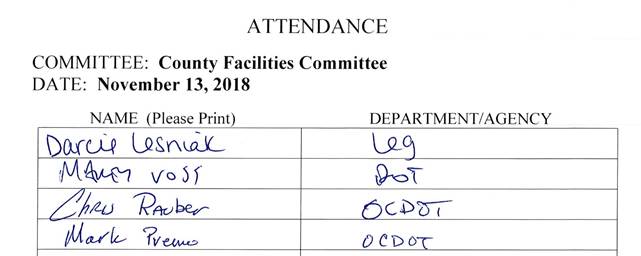
* * *
ENVIRONMENTAL PROTECTION COMMITTEE MINUTES - NOVEMBER 14, 2018
MICHAEL E. PLOCHOCKI, CHAIRMAN
MEMBERS PRESENT: Mrs. Tassone, Dr. Chase, Mr. Burtis
MEMBERS ABSENT: Ms. Cody
ALSO ATTENDING: See attached list
Chairman Plochocki called the meeting to order at 9:05 a.m. A motion was made by Dr. Chase, seconded by Mr. Burtis, to waive the reading of the proceedings from the previous committee. MOTION CARRIED. A motion was made by Mr. Burtis, seconded by Dr. Chase, to approve the minutes of the previous committee meeting. MOTION CARRIED.
1. WATER ENVIRONMENT PROTECTION: Tom Roads, P.E., Commissioner; Michael Lannon, P.E., Deputy Commissioner
Chairman Plochocki stated this is a 3-step process. Last month the committee briefly spoke about these projects and voted for public hearings. The projects are informational this month and will return to the committee in December for a vote. The legislature will then vote on the projects at the December 18th session.
a. INFORMATIONAL: Approving Proposed Improvements for the Onondaga County Sanitary District Consisting of the Metro Thickener Rehabilitation Project in and for the County of Onondaga, New York
b. INFORMATIONAL: Authorizing the Issuance of $3,730,000 Bonds of the County of Onondaga, New York, to Pay Costs of Improvements for the Onondaga County Sanitary District Consisting of the Metro Thickener Rehabilitation Project ($3,730,000)
Mr. Rhoads:
-
Memorandum of support included with the packet relates to the public hearings; distributed revised memorandum noting just the titles at the top of the pager were different - approving and authorizing projects and bonds
-
Toured plant last month, saw underground and aboveground infrastructure including the digester and thickeners, built circa 1978, reaching end of useful life, scoring 4 out of 5 with 5 being equipment that has failed
-
All 3 thickeners in pore repair, components are worn-out, biosolids failures drive up disposal costs and can impact process controls allowing for permit failures, a real business case for replacement, difficult to maintain mechanical equipment in this environment beyond 30 years, now in the 40-year timeframe
Chairman Plochocki asked Mr. Rhoads to make it clear for the record the importance of thickening the biosolids. Mr. Rhoads responded that the biosolids need to be thickened in order to be properly digested. The thickening process allows digestion and the digestion enables us to reduce the amount of material disposed of by almost 50%; currently pay about $4 million per year for disposal. If we were unable to digest properly that number would double. In addition, we would not be able to manage these solids appropriately in which case they would recirculate through the plant and cause SPEDES permit failures and violations for excess nutrients going into Onondaga Lake.
- Only replacing assets in need, use asset scoring for scarce resources
c. INFORMATIONAL: Approving Proposed Improvements for the Onondaga County Sanitary District Consisting of the Brewerton WPCP Asset Renewal Project in and for the County of Onondaga, New York
d. INFORMATIONAL: Authorizing the Issuance of $12,575,000 Bonds of the County of Onondaga, New York, to Pay Costs of Improvements for the Onondaga County Sanitary District Consisting of the Brewerton WPCP Asset Renewal Project ($12,575,000)
-
1974 facility, mainly original equipment, significant service area - the Town of Cicero and a small portion of the Town of Clay; Parade of Homes development immediately adjoined on the Westside of the plant, built in 2014, some evolving neighborhood issues
-
Bringing facility up to compliance with a number asset management things, code compliance, and odor control; completely changing aeration system, more energy efficient - we are the largest user of power in the county, aeration is used to remove nutrients and uses a tremendous amount of energy
In answer to Chairman Plochocki, Mr. Rhoads confirmed that he is speaking holistically of the system when referring to it being the largest power consumer, not just the Brewerton plant.
-
Includes relocation of operation controls and aging concrete repairs; if investments aren’t made now the degradation will be more severe and much more expensive later, interest rates are also going up, the timely investment decision is important; also includes life safety improvements and code compliance repairs
- Each dot on the risk scale refers to a piece of equipment, look at the consequence and risk of failure based on the likelihood of failure
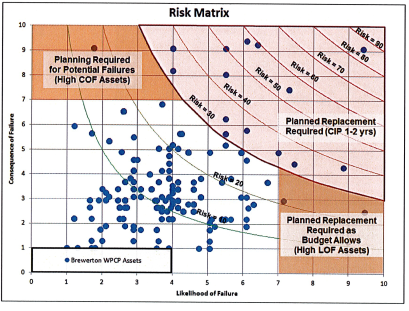
- Trying to make incremental improvements; original cost about $13 million, the in-kind replacement would be well north of $70 million
Mr. Burtis asked if these improvements will last as long as they previously did or will it be like his current TV, which is cheaper but doesn’t last as long. Mr. Rhoads responded that previously things were built very stout, the motors, equipment, and housing were oversized, there were factors of safety. In today’s age of economy, everyone is making their product razor close to the necessary safety margin which sometimes erodes the length of usefulness. However, this is not something we can control. We also suffer from trying to get parts for old equipment that is no longer available, i.e. scavenge eBay to find parts for some control systems.
Mr. Burtis stated that he supports all these items and asked if they sometimes pay in cash even though we say we are going to bond. Chairman Plochocki responded that in theory, this applies to all departments and projects. Mr. Rhoads added that sometimes there is a mix. In recent times a portion of our fund balance was used for the Westside pump station. WEP typically uses its fund balance funds to float some construction until bonding for the projects. The Brewerton project is $12,575 million, before building permits, which is the maximum amount we are allowed to spend. The chief fiscal officer goes to market each year and only borrows what is necessary; typically staggered over the life of the project, not a lump sum. Chairman Plochocki said that a very general rule is that when the costs are low enough there is more incentive to use cash. Once you get beyond a certain point we always bond.
In answer to Mr. Burtis, Mr. Rhoads stated the historic term for borrowing is 20 years; borrowed $70 million for 30 years with the Clinton project. Historically the period of probable usefulness (PPU) is north of 20 years. Engineering can only be 5 years PPU.
Dr. Chase asked where the plant was located and if it was on the lake. Mr. Burtis responded that it was located on the river almost on the line for the Towns of Cicero and Clay. Mr. Rhoads stated the Mary Gates would be reaching out to Mr. Burtis in reference to taking a tour. Chairman Plochocki asked that the arrangement for the tour be shared via email to all. Dr. Chase noted that the plant was in place before the homes were built. Mr. Rhoads added that plant was there for about 40 years before.
Dr. Chase asked if the cement wall things were on the river. Mr. Rhoads responded that they are back from the river a little and are not affected by it much. This plant supports all the lakeside development. Prior to this plant, and all the pump stations along the way, there were serious problems in the lake because of failing septic systems. Dr. Chase asked if they had a sewer system. Mr. Rhoads responded that for the most part, the Town of Cicero owns the mainline sewers in the middle of the street, which typically go to different trunk sewers that go to pump stations, the pump stations convey the water via force mains to the wastewater treatment plant. There is very high groundwater in the area, as soon as the older sewer joints start breaking we have infiltration. Cicero has been working with us and requires new development to have an offset of 1 to 1 per gallon. If the developer cannot remove the water they pay $4 per gallon which goes into a fund for sustainability of the system. We encourage others to follow the lead that Cicero and Fayetteville have been taking. Chairman Plochocki stated that it was worth noting for the record that this is a big priority for County Executive McMahon. Mr. Burtis stated that the county has given Cicero a lot of money to work on I&I because capacity is a big issue. They have had some gains in removing I&I but there are also private septic systems that make it a challenge. The pump stations were just redone so moving onto the wastewater treatment plant is all part of the plan.
-
Much of the infrastructure was built in the ’70s with Clean Water Act funding – 75% federal and 12.5% state money, much construction in our community at that time, now all reaching its 40 year horizon; also had ACJ that required close to $700 million be spent on combined sewer overflows in the city, now have to pay the piper for forgoing investments in other assets because of the compelling consent orders
-
Likely facing additional consent orders, i.e. Meadowbrook Limestone and Ley Creek force main; all orders come with some kind of penalty payment and a condensed timeframe which drives up costs; communicate to peers if we don’t make these improvements we will be required to make them under duress
e. INFORMATIONAL: Approving Proposed Improvements for the Onondaga County Sanitary District Consisting of the Metro Digester Phase II Improvements Project in and for the County of Onondaga, New York
f. INFORMATIONAL: Authorizing the Issuance of $27,680,000 Bonds of the County of Onondaga, New York, to Pay Costs of Improvements for the Onondaga County Sanitary District Consisting of the Metro Digester Phase II Improvements Project ($27,680,000)
-
After thickening moves onto the digester complex, have real serious issues with the infrastructure, floating cover no longer floats, unable to store most of the gas used for our combined heat and power system
-
Bundling this project with a pair of additional natural gas combined heat and power grant project; the resolution will be presented next month to approve $1 million+ grant
-
1959 vintage equipment, managing biosolids is tricky, they like to be 98.6° or will overflow and not digest properly, cost us real money; this complex digests the sludge for 5 of the 6 treatment plants, centralization provides economies of scale, digesters very expensive to build, use heat typically generated from the gas made from anaerobic digestion - not using aeration, this is a way to reduce the amount of biosolids and consume the nutrient matter without adding oxygen, creates methanol gas used for energy
-
Well beyond its useful life, primary project of all the projects presented; $27.7 million before the costs of building permits, which we would like to discuss
-
Thanked the committee for visiting last month and hopes they relate to their peers the necessity for infrastructure investments
Chairman Plochocki stated that aside from the tour being helpful in general, part of the reason there aren’t further questions is that seeing is believing. This is our second bite of the apple informationally and we have also had the opportunity to reach out to Mr. Rhoads and Mr. Lannon individually. Don’t take lack of questions as lack of interest as the committee has been educating itself factually and visually.
g. INFORMATIONAL: Approving Proposed Improvements for the Onondaga County Sanitary District Consisting of the Metro Biosolids Drying Project in and for the County of Onondaga, New York
h. INFORMATIONAL: A Resolution Authorizing the Issuance of $15,106,000 Bonds of the County of Onondaga, New York, to Pay Costs of Improvements for the Onondaga County Sanitary District Consisting of the Metro Biosolids Drying Project ($15,106,000)
For the record, Chairman Plochocki asked Mr. Rhoads to explain why the process of drying the sludge is so important. Mr. Rhoads responded that presently biosolids are run over a belt, solids remain on top and liquids pass through, it then goes through a centrifuge that squeezes the water out of the biosolids. At the top of our game, it runs about 30% solids and 70% water and is almost the same by weight. Biosolids are disposed of in a landfill so then 70% of our disposal costs relates to water. This adds an additional process, after the centrifuging, roasting the biosolids in a heated dryer to drive off the additional moisture which would get to water weight of about 10%.
-
Provides a tremendous disposal cost reduction; estimated payback rate 8.1 to 11.1 years, comports very well with the 20 year borrowing period, 2016 disposal cost was in the $50 per ton neighborhood, recently spiked north of $70, now close to $80 per ton, that change caused us to revisit this project from an energy conservation standpoint - less disposal and transport, in the long run, could begin to look at opportunities for land application of biosolids on crop fields not for human consumption, further improving our payback period
-
Requires new building construction and dryers, will significantly change the material from a sludgy cake to a dust-free pellet which improves handling characteristics; building will incorporate all the dryer and odor control systems
- Metro campus built on poor soils, very long piles almost 300 feet under everything, foundation and pile driving is a significant portion of this project
Chairman Plochocki asked that the aimed percentage for solids to water be noted for the record. Mr. Rhoads responded, “This project would move the current 30% dry content to 90% dry content are our goals.” Chairman Plochocki said that this is essentially a system-wide improvement as biosolids are trucked into Metro. Mr. Rhoads respond that the Baldwinsville campus manages its own biosolids. Once this is up and running we will probably review how Baldwinsville’s sludge is managed and perhaps move them in. In answer to Chairman Plochocki, Mr. Rhoads agreed that this is for more than just Metro. When we say Metro produces almost 100,000 tons of sludge per day it includes almost all the facilities we operate. Dr. Chase asked what Baldwinsville does with their sludge. Mr. Rhoads responded that they have belt presses and Baldwinsville is unique as there is a digester at Wetzel in case there is a hiccup in the system. It is important to have a little redundancy in the system. If there is a problem at Metro a little bit of biosolids can be sent to Baldwinsville for pressing but for the most part Metro takes care of all of our biosolids. Dr. Chase asked the percentages taken out at Baldwinsville and if their process is newer. Mr. Rhoads responded that Baldwinsville’s system is the same vintage and has its moments when they are happy to get into the mid 20’s. Once this is up and running we will look at the cost of trucking and managing the biosolids differently. Metro would have the capabilities to manage all the biosolids systemically in this dryer.
Chairman Plochocki asked if the term “dewatering” applies to this. Mr. Rhoads said that this is what he calls drying – apply heat energy to dry. Dewatering is typically about using some sort of gravity process. Chairman Plochocki said that it was a different process but the goal was the same. Mr. Rhoads agreed, i.e. putting oatmeal on a paper towel won’t reduce much water, put it in an oven to dry and it becomes much drier.
Chairman Plochocki asked for a motion to adjourn.
Dr. Chase asked to talk about the Murphy’s Island situation adding that it sounds like it is just going to go the route they have chosen. Chairman Plochocki stated his understanding is that the legislature approved the money for the trail last December and made a non-binding memorializing resolution as to what we wanted the trajectory to be. At that point, everything switched over to the executive branch side of the house and from then on it has been their game. Accordingly, he has been referring all questions, beyond basic procedural, to Mr. Glazier of the Office of Environment who is the past and current county executive’s point person on this issue. The committee continued to discuss the topic to which Chairman Plochocki again referred all questions to Mr. Glazier. Chairman Plochocki added that any increased costs would have to come before the legislature and because this is not on the agenda he would rather not discuss this in too much detail.
A motion was made by Chairman Plochocki, seconded by Mr. Burtis, to adjourn. MOTION CARRIED.
The meeting was adjourned at 10:03 a.m.
Respectfully submitted,

KATHERINE M. FRENCH, Deputy Clerk
Onondaga County Legislature
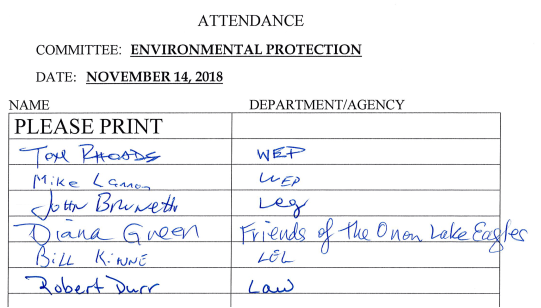
* * *
PUBLIC SAFETY COMMITTEE MINUTES – NOVEMBER 14, 2018
CHRISTOPHER J. RYAN, CHAIRMAN
MEMBERS PRESENT: Mr. Rowley, Mr. McBride, Mr. Bush, Mr. Jordan
ALSO ATTENDING: Chairman Knapp, Mrs. Ervin; See attached list
Chairman Ryan called the meeting to order at 12:06 p.m. A motion was made by Mr. Jordan, seconded by Mr. Bush to waive the reading of the minutes of the previous committee meeting; MOTION CARRIED. A motion was made by Mr. Jordan, seconded by Mr. Rowley to approve the minutes of the previous committee meeting; MOTION CARRIED.
1. DISTRICT ATTORNEY: Barry Weiss, Administrative Officer
a. Transfer from District Attorney, Account 694080 Professional Services, to District Attorney, Account 641030 Other Employee Wages, $33,000
- Transfer for 5 part-time Investigators - looking for individuals for homicide trials, and security for witnesses
- Hours worked between 6 p.m. and midnight; people they are looking for do not typically work 9 – 5
Mr. Weiss responded to Chairman Ryan that the increase is beyond the original budget in lieu of using overtime. The department has never had to use overtime.
Mr. Jordan said they are taking money out of Court Transcriber fees leaving $37,000 in that account, and asked if that will be sufficient. Mr. Weiss answered yes. Chairman Ryan wanted clarification that there would not be overrun in that line, and Mr. Weiss said yes; it was discussed with Management and Budget.
Mr. Weiss explained to Mr. Rowley that the positions are all part-time, and are on an as needed basis.
Mr. Bush asked where these people come from, and Mr. Weiss replied that they are former members of the Syracuse Police Department. Most are retired investigators from the Criminal Investigation Division. Mr. Bush asked if they reach out to other police departments. Mr. Weiss said it depends on the retirement system, and explained that they cannot hire Deputy Sheriff’s, because it is another County agency. Mr. Weiss agreed with Mr. Bush that they could use people from (i.e.) the Town of Baldwinsville or Camillus. The word gets around.
A motion was made by Mr. Jordan, seconded by Mr. Bush, to approve this item. Passed unanimously; MOTION CARRIED.
2. SHERIFF’S DEPARTMENT: Captain Paula Pellizzari
a. Transfer from Sheriff’s Office, Account 641010 Regular Employee Salaries, to Sheriff’s Office, Account 641020 Overtime Wages, $1,500,000;
Transfer from Sheriff’s Office, Account 691200 Employee Benefits-Interd, to Sheriff’s Office, Account 641020 Overtime Wages, $500,000;
Transfer from Sheriff’s Office, Account 641030 Other Employee Wages, to Sheriff’s Office, Account 641020 Overtime Wages, $12,000
b. INFORMATIONAL: Budget Projections
-
Ask to move $2,012,000 from 101 and Employee Benefits lines to cover overage in Overtime line
-
Number of vacant positions – Police, Custody and Corrections; many of those positions required staffing, so filled using overtime, causing an increase in overtime
-
CAC (Centralized Arraignment Court) – ~$368,000 in overtime in Custody that was not in budget
-
With many vacant positions, there is extra money in 101 line and employee benefits
Captain Pellizzari responded to Chairman Ryan that this month’s projection has $368,627.10 for CAC overtime. These numbers are provided each month by the Custody Department to Taviot (Jackowski), and she calculates what part of the overtime is connected to CAC. Last month’s document was provided by Chief Andrews, and Captain Pellizzari is not familiar with that document. There is a version of the spreadsheet with CAC as a separate line, but it is not a budget line. It is a way to see where the money is. The backup given to the committee shows what was spent for CAC as part of overtime, salaries and supplies.
Chairman Ryan asked Captain Pellizzari to ballpark how much overtime is for the perspective departments. Captain Pellizzari answered:
- Total is the Sheriff’s overall projection, but it is broken down by Sheriff, Police, Custody, Civil and Corrections
- Custody overtime is over budget by $515,945
- Police overtime is over budget by $507,678
- Civil overtime is under budget by $16,542
- Corrections overtime is over budget by $1,004,522
- Sheriff overtime has no budget or use
Chairman Ryan asked about the All Other Expenses line, and Captain Pellizzari explained:
-
Reason for now showing under budget compared to last month showing over is because Corrections has new washing machines in the CIP
-
In operating budget, Corrections was approved for part-time laundry work from a company called Lazy Bones Laundry
-
Intent to move to doing their own laundry, so all of Lazy Bones was cut from the budget; but they did not have employees hired or washing machines; several months into 2018, Lazy Bones was still providing service
-
Washers now installed; dryers are new (due to a fire); employees are now hired
-
Because it was not budgeted, it showed over budget; moved expenses to telephone account
-
Coming in under budget in all lines except overtime; overall under budget
Mr. Rowley is concerned with overtime being managed properly, and said there is potential for it to get out of control. In 2017, the overtime was significantly less than what is being projected for 2018. Mr. Rowley requested an analysis of last year’s overtime versus this year’s. It was said it was due to a lack of personnel, but if the numbers are correct, there is a $2 million dollar difference. It does not seem that the County would lose that much personnel to drive that overtime. Captain Pellizzari said part of it is that the Sheriff’s Department took over Corrections, and inherited their budget. $1 million of that amount is just for Corrections. There is around $500,000 for Police and $500,000 for Custody. The CAC is a big part of overtime for Custody, and Police has vacancies as well as unexpected large investigations. Mr. Rowley would like to know what was spent last year in overtime, what was spent this year, what were the drivers, and is there enough budgeted in 2019. Captain Pellizzari said in their request, Taviot put together the numbers of what they are projected to spend in 2018, and that determined what they requested in 2019. Captain Pellizzari can gather more information if Mr. Rowley would like, and Mr. Rowley responded no. Mr. Rowley asked if they will make budget, and Captain Pellizzari replied they are hoping this move $2,012,000 will cover them for the end of the year.
Mr. Jordan wanted clarification on the Employee Benefits line, because the projection only shows the 125 line with $14,000 being budgeted, and the transfer is for $500,000. Captain Pellizzari explained:
-
That Employee Benefit line (125) is where they pay Guardian Life Insurance
-
Employee Benefit line (120) is an interdepartmental line, which is not shown
-
Because of vacancies, they did not use some Employee Benefits (120) related to 101; these benefits are not part of the line paying Guardian Life Insurance
-
Entire budget has several lines of interdepartmentals; no control - handled by Management and Budget (DMB)
-
Taviot, Megan (Granteed) and I worked together to came up with a plan to best identify funds to pay for overage
-
DMB has the numbers; confident that they have the right numbers and enough to cover remainder of expenses
Mr. Jordan suggested that if they are showing a budget projection and where they will be, then interdepartmentals are part of that budget. This is not giving a picture of the entire budget, when they are omitting millions of dollars. Captain Pellizzari said if they would rather see the entire budget, it is not a problem at all. They will include it on the projections. Ms. Granteed stated she is confident they will have enough, and the calculation is based off of the 101. Ms. Granteed replied to Mr. Jordan that the template was for direct expenses only.
Chairman Ryan asked if they are in a good place with the ratio of staff to inmates. In the short term they are transferring in excess of $2 million, so do they need to put more people on. Captain Pellizzari responded:
-
Trying to resolve Custody and Corrections side; combined academy in place to hire for both
-
Canvased list and interviewed - only able to get 18 candidates that were qualified, out of 30; currently down to 15 (maybe they decided the job was not right for them, or they did not make it)
-
15 candidates - 2 Custody Deputies; 3 Juvenile Transport Officers and 10 Corrections Officers; graduate at end of February, then field training; will be a while before in position to help prevent overtime
-
Discussions about moving forward with another academy; looking at Police side – can look at the list right now, or test in November (which will identity further candidates)
-
Hope to hire 25 for next Police hire; do not generally have problem identifying Police people; it’s more the amount of time it takes to get through the hiring process and academy
-
Police refers to Police Dept., and starting as road patrol; Custody and Civil are same civil service test and academy
-
Problem is getting enough qualified candidates; lot of recruiting – had more people take the test this time; also have to pass polygraph, medical exam, etc.
-
Goal last time was 30, but hired 18; all 18 went to academy, and now down to 15; 25 to hire on Police side
Chairman Ryan believes they are short staffed, and asked what they are doing in the long run. What is beneficial to the taxpayers? What is beneficial to public safety?
Mr. McBride asked if the issue is quality or quantity. Captain Pellizzari believes it’s both. They need the quantity to take the exam, and they need to get through the process of their standards of a clean criminal record, no drug use, passing a polygraph and a background check. Captain Pellizzari responded to Mr. McBride that they usually lose the candidate in that last phase. The first step is getting more people to take the test. Another way to get employees is transferring a candidate from another agency, which means they do not need the academy.
Mr. Bush asked if there are educational requirements for these positions. Sheriff Conway answered that passing the civil service exam is a requirement, then they have to be proficient in the academy (separate set of requirements). There are standards by DCJS to be met in the academy whether academic or physical; most requirements are state requirements. Sheriff Conway responded to Mr. Bush that they need a high school education or GED, but there are no college requirements.
Mr. Bush left the meeting.
Mr. McBride asked if there are age requirements. Sheriff Conway said yes and no.
-
On the Police side there is a cap, but on the Custody and Correction side, there is not; (i.e.) 50 year old candidate for Corrections may struggle with the physical side at the academy
-
Recognize they are struggling to find candidates for Custody and Corrections; list got exhausted and still have positions
-
Went to civil service to speed up next exam, which will be given several months ahead of time
-
Did some unusual recruiting, which brought up number of people to sign up for test
-
Reached out to other Custody and Corrections people – state system; some interest from them
-
Thinking outside the box to fill positions to prevent overtime issue; always chasing vacancies; nature of law enforcement
-
Continue to support combined academy with Custody and Corrections at OCC; when Police list available, will again try to combine those to expedite coming out of academy
-
Going back to the drivers of overtime question - want to remind the committee of 2 big drivers:
- Centralized Arraignment costs – at meetings Sheriff Conway said they will incur huge costs, but was told it would not happen; at the end, took it on the chin; new shift of 24/7 deputies – used to only be 4 days per week, not 7; did make adjustments; eliminated a supervisor; another unfunded mandate costing overtime
- Inherited Corrections budget; did not have say in what budget would be; learning and trying to make adjustments
Mr. Jordan asked if they reach out to any Veteran’s organizations for recruiting. Sheriff Conway replied that they sent people to Fort Drum, and Veterans are always included in any recruiting, because they are some of the best candidates.
Chairman Knapp stated that every other department had their requirements funded for Centralized Arraignments, except for the Sheriff, so he appreciates the Sheriff making it a success.
Chairman Ryan stated that Megan will get the budget with the benefits to Casey (Jordan), and Ms. Granteed agreed. Chairman Ryan requested a copy of the breakdown of the departments.
A motion was made by Mr. Rowley, seconded by Mr. Jordan, to approve this item. Ayes: 4 Absent: 1 (Bush); MOTION CARRIED.
3. PROBATION: Andrew Sicherman, Commissioner
a. Amending the 2019 County Budget to Accept Funds in Connection with a Grant from New York State Office of Mental Health, and Authorizing the Execution of Agreements ($234,709)
-
Enhanced Pretrial Release Program - have standard Pretrial Release currently that is run by a private agency
-
Pretrial Release – opportunity for individuals to get released from jail that cannot post bail; form of ROR (release on your own recognizance); Judge orders it, and pretrial release agency meets with people by phone or in person
-
Purpose to make sure individual is aware of court date (primary focus of standard program), and get to court
-
Extremely important program - way to get people out of jail to be successful in another way; reduce incarceration costs
-
Enhanced program focuses on individuals in Justice Center with severe and not so severe mental health problems
-
Proposing to have additional Probation Officer and 2 Case Managers (aka Care Coordinators)
-
Screen jail and find candidates that can be safely released; offer assistance with monitoring by assigned Probation Officer; this includes transport, scheduling appointments, keeping appointments, etc.
-
For individuals after arraignment, and prior to disposition
-
Hope to let some folks out of jail - if it were not for mental health issues, they would not be in there
-
Will also assist with medications and therapy; see case through to end, and follow up to track success of program
Mr. Sicherman responded to Chairman Ryan that this does match well with Recovery Court, which is scheduled to start at the first of the year.
-
Some of the individuals (from the pretrial release) will become Recovery Court clients – Recovery Court is a program for misdemeanors in City Court with Judge Andrews
-
If the program is approved, while a case is pending, they can safely release the individual, and can transfer the case to Recovery Court – provided it meets requirements: has to be misdemeanor and a City Court case (talk about bringing in Justice Court cases as well)
-
Recovery Court will not have Case Managers, but Treatment Providers; Probation Officer will do home visits
-
Currently with Pretrial Release, they do not do home visits; with Enhanced Pretrial Release, they will do home visits, work with family members and Care Coordinators; get the person to be successful; not in the Justice Center
-
Plenty of candidates to share in this endeavor with how much mental health issues are there
Mr. Bush returned to the meeting.
Mr. Jordan asked if there is an evaluation process that goes on before someone is accepted into the program, because he does not want to put residents at risk with someone who has a psychiatric disorder. Mr. Sicherman agreed, and said that he is in the process of putting a plan together. There is a screening the jail does to identify mental health folks, plus the Care Coordinators will go into a full biopsychosocial assessment. They will work with the Probation Officer and Administration to say this person is or is not a good candidate. Mr. Sicherman said they will also do a COMPAS, which is an assessment Probation does on every client to help determine the risk of violence and risk of recidivism. Mr. Rowley asked if the court signs off on their determination, and Mr. Sicherman answered yes.
A motion was made by Mr. Rowley, seconded by Mr. Jordan, to approve this item. Passed unanimously; MOTION CARRIED.
A motion was made by Mr. Rowley, seconded by Mr. McBride, to adjourn the meeting. Passed unanimously; MOTION CARRIED.
The meeting was adjourned at 12:53 p.m.
Respectfully submitted,

JAMIE McNAMARA, Assistant Clerk
Onondaga County Legislature
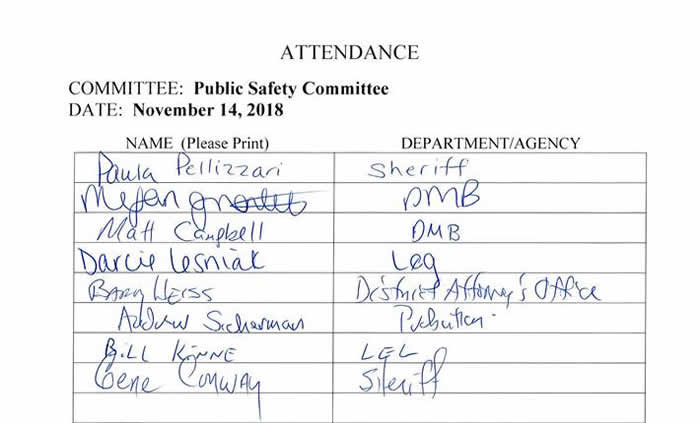
* * *
HEALTH COMMITTEE MINUTES - NOVEMBER 15, 2018
TIMOTHY T. BURTIS, CHAIRMAN
MEMBERS PRESENT: *Ms. Cody, Dr. Chase
MEMBERS ABSENT: Mr. Rowley, Ms. Williams
ALSO ATTENDING: see attached list
Chairman Burtis called the meeting to order at 9:41 a.m.
1. HEALTH: Indu Gupta, M.D., M.P.H.
a. Informational Update
- 1st quarter 2019 - annual report will be emailed to Legislators; would like constructive feedback
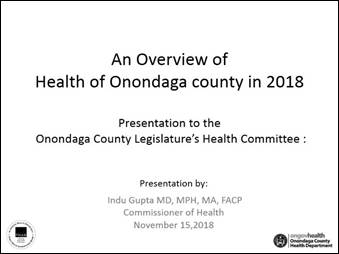 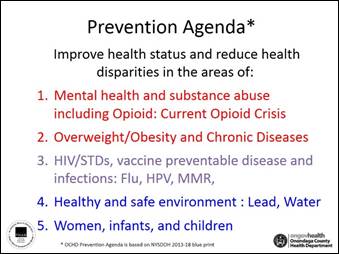
 
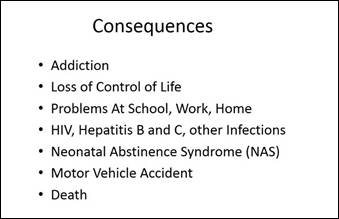 
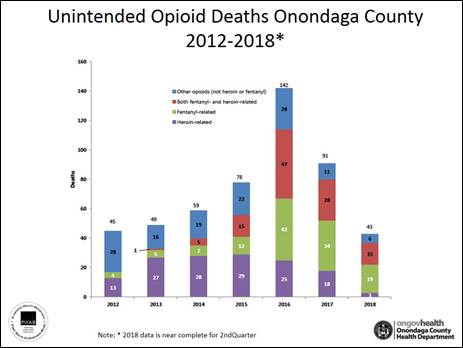
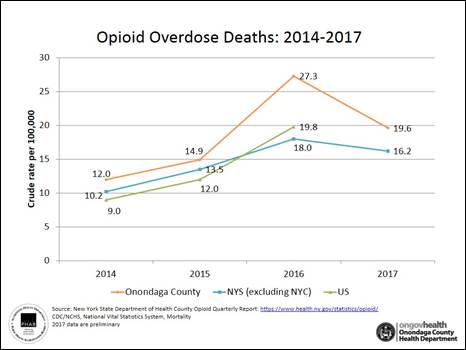
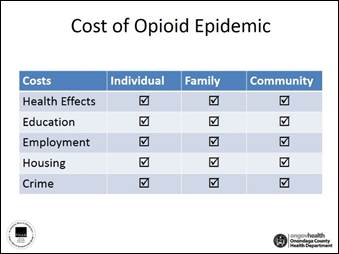
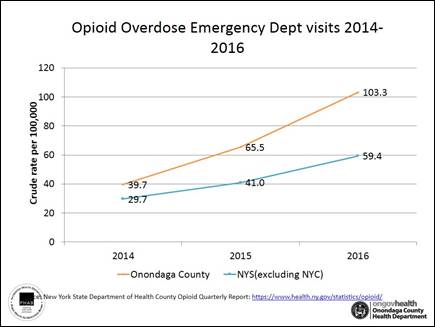
- Emergency room visits are up, which is a good sign; means people are getting in to receive treatment
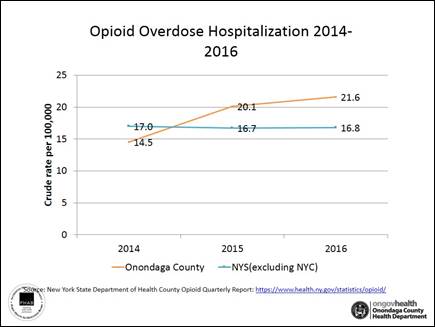
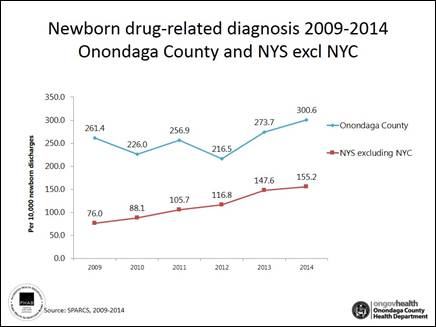
*Ms. Cody arrived at the meeting.

-
Crisis – working with community to help save people; Naloxone – life saving drug; ensure people are trained to save lives whether at a mall, street side, etc.
-
Law Enforcement important partners – DA, Sheriff, County Probation Officer – addressing in empathetic way
-
Working with Emergency Management and Law Enforcement to come up with Onondaga County map for drug overdose; not only opioids, but also synthetic drugs
-
Kevin Sexton, IT Commissioner working with everyone in leadership to come up with digital map
-
Any first responder puts in information to create map; will be informational; can inform community and providers that (i.e.) there may be bad batch of synthetics; raise awareness in community
-
Treatment – Crouse has more funds; expansion by providers with behavioral health and treatment sites
-
At forefront for addressing everything
-
Prevention – need to do, otherwise circling; people being screened for mental illness; providers to ask right questions
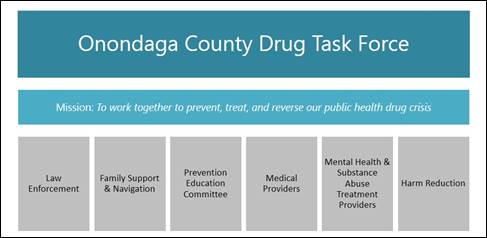
 
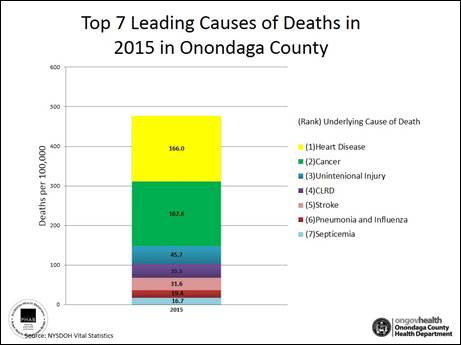
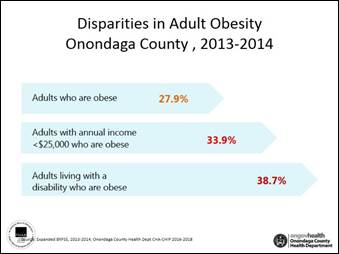 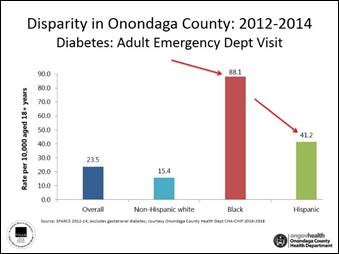
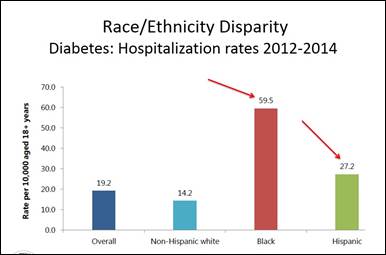
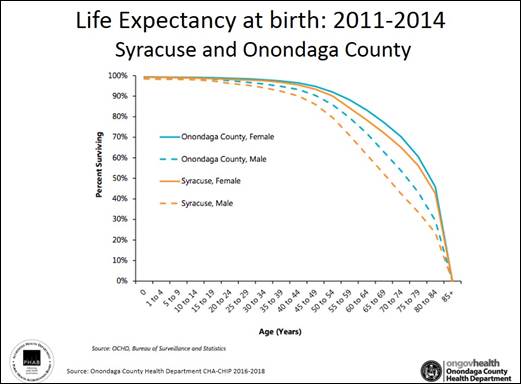
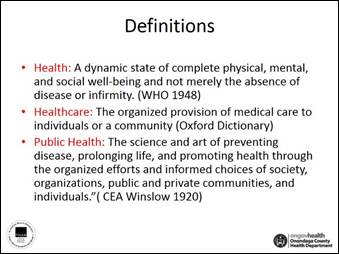 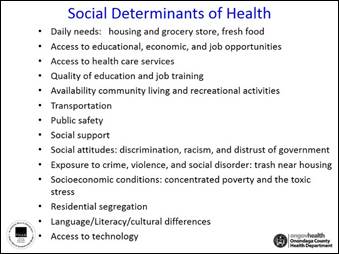
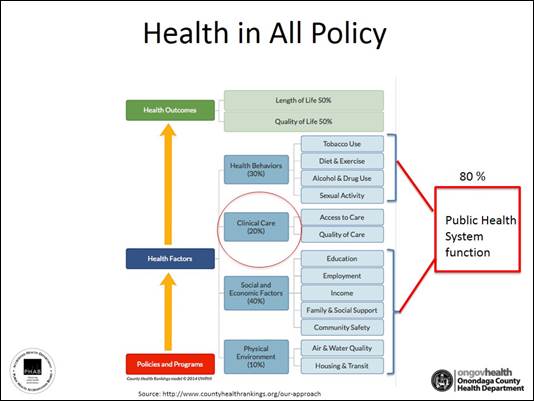
 
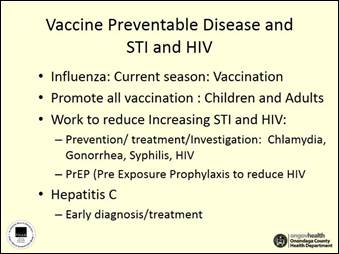 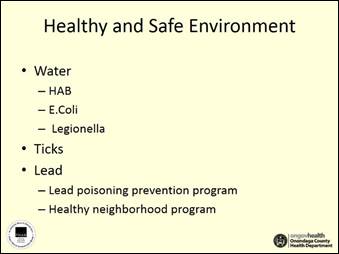
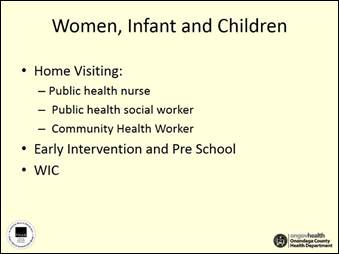 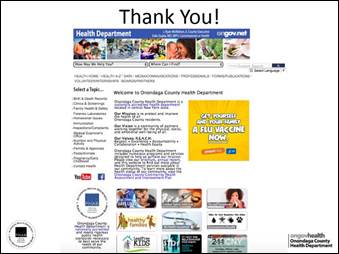
Chairman Burtis thanked Dr. Gupta and her team, who have done a lot of things in a good way. Chairman Burtis stated that his town was the first to bring on Narcan, so he had to bring himself up to speed on that. Also, his Brother-in-Law is in the process of adopting a baby from the City whose mother had been addicted to drugs her whole life. The little girl has affects today due to her mother’s drug abuse. Chairman Burtis said it is very sobering.
Dr. Chase said, during the Healthy Babies presentation, it was disturbing to hear that pregnant women still smoke. Dr. Gupta commented:
-
Great point; it has not gone down
-
Social determinations come into the picture; continue to provide educational material and outreach; connecting to Smoking Cessation Program; also look into why they are smoking
-
As clinician, see people are stressed, smoking makes them feel better; women who smoke may have economic disparity or many other negative factors; it becomes a way out
-
All things help including (i.e.) Tobacco 21 and Syracuse Housing coming out with a policy; all provide healthy and safe environments; people forced not to smoke; less smoking exposure
-
Not perfect world; work still to be done; continue to hone in on that
-
Participant of Healthy Babies spoke saying she was a smoker that quit; should talk to this individual and make her a champion; have her talk to peers; need to find creative ways for people to be more accepting of message
-
(i.e.) Kids listen to friends more than their doctor mother; pregnant woman listen to pregnant woman
-
Important with engaging community members and partners; doing it alone makes it harder; connectivity to a partner, father and/or family fills the void; postpartum is a very vulnerable time – need support
Dr. Chase asked if they have zip code data, and Dr. Gupta said yes, but the numbers are very small. It is all over, and not concentrated in one area. There are also proportionate deaths in races and ethnicities. The overdose map might give information on where drug dealers are focusing and engaging. Dr. Gupta responded to Dr. Chase that they do not have the map yet. There are multiple agencies involved, lots of resources, and no funds. It is an extra job, and people are doing it, because they are committed to the work.
Ms. Cody said she went to a forum the State Department did on recreational marijuana, and people talked about how it will be regulated. Ms. Cody asked if Dr. Gupta has had an opportunity to weigh in on this with the state. Dr. Gupta replied:
- Yes; state came and talked with County Health Association
-
Complicated issue; still work in progress; legalization of marijuana in almost 11 states
-
Health Department looking cautiously at Colorado Health Department, who has put information out, including consequences - anyone thinking of legalization should take consequences into consideration
-
Concern - public health implications are significant with (i.e.) addiction potential, impacting brain development in kids, and expectant mothers using it to reduce vomiting
-
How much information is out there? Medicine evidence not there; do not think it will be great idea
-
Feedback to state has been to consider all things when thinking of going forward; put protective measures in beforehand; put in policy of how it will be regulated, who will be in charge, and who will be monitoring it
-
Should have funds allocated at state and local level for prevention, education and surveillance; monitoring is crucial
Ms. Mignano invited the committee to an acknowledgement of the Health Department staff for their accreditation. Dr. Gupta said it will be on December 4th when they have their Health Advisory Board meeting, so the committee is welcome to attend both. From 9 a.m. – 11 a.m. they will do an open house.
A motion was made by Chairman Burtis, seconded by Ms. Cody, to adjourn the meeting. Passed unanimously; MOTION CARRIED.
The meeting adjourned at 10:29 a.m.
Respectfully submitted,

JAMIE M. McNAMARA, Assistant Clerk
Onondaga County Legislature
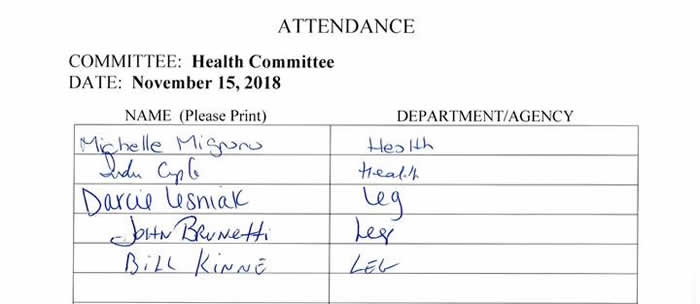
* * *
PLANNING & ECONOMIC DEVELOPMENT COMMITTEE MINUTES - NOVEMBER 15, 2018
JOHN D. McBRIDE, CHAIRMAN
MEMBERS PRESENT: Mr. Holmquist, Mr. Buckel, Mr. Burtis, Mr. Plochocki
ALSO ATTENDING: Chairman Knapp; see attached list
Chairman McBride called the meeting to order at 10:36 a.m.
A motion was made by Mr. Burtis, seconded by Mr. Plochocki, to waive the reading of the proceedings from the August committee. MOTION CARRIED. A motion was made by Mr. Buckel, seconded by Mr. Burtis, to approve the minutes of the August committee meeting. MOTION CARRIED.
A motion was made by Mr. Burtis, seconded by Mr. Plochocki, to waive the reading and approve the minutes of the proceedings from the previous committee MOTION CARRIED.
1. VISIT SYRACUSE:
a. Designating Visit Syracuse as the Agency Authorized to Make Application to the New York State Department of Economic Development and to Receive Matching Funds Therefrom Under the New York State Tourist Promotion Act for 2019
A motion was made by Mr. Holmquist, seconded by Mr. Buckel, to approve this item. Passed unanimously; MOTION CARRIED.
2. Memorializing Support for the North Country National Scenic Trail and Concurrent Finger Lakes Trail/Onondaga Trail in Onondaga County (Sponsored by Mr. Knapp)
Chairman Knapp:
-
The trail starts in North Dakota, travels to the coast and part passes through Onondaga County; passed a similar resolution about 20 years ago, no funding attached, needed for grant applications and land purchases for additional trails, shows county’s support for their efforts
-
Trail rich community with Loop the Lake, Highland Forest, Pratt’s Falls, and Beaver Lake; huge trail symposium coming next year – one reason is these great trails
Mr. Durr confirmed there was no downside. Chairman McBride asked if there was any expectation that they would come to us for money. Chairman Knapp responded that they never have; 16 miles of the trail are located in our county. We do not have a large piece of it but they hit every county along the way.
Mr. Burtis said that the resolution states half of it is located on private land, i.e. snowmobile trails. Chairman Knapp responded that it was mostly walking or hiking trails and actually links with Highland Forest in the Town of Fabius.
A motion was made by Mr. Plochocki, seconded by Mr. Burtis, to approve this item. Passed unanimously; MOTION CARRIED.
A motion was made by Mr. Burtis, seconded by Mr. Plochocki, to adjourn the meeting. Passed unanimously; MOTION CARRIED.
The meeting was adjourned at 10:43 a.m.
Respectfully submitted,

KATHERINE M. FRENCH, Deputy Clerk
Onondaga County Legislature
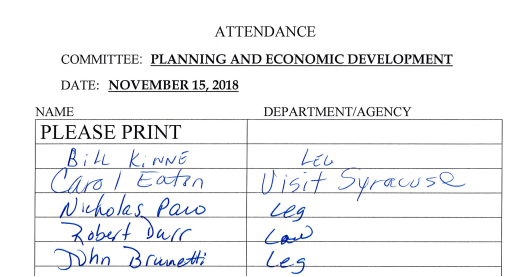
* * *
WAYS AND MEANS COMMITTEE MINUTES
NOVEMBER 26, 2018
DEBRA CODY, CHAIR
MEMBERS PRESENT: Mr. Ryan, Mrs. Ervin, 2Mr. Plochocki, Mr. May, 1Mr. Jordan
MEMBERS ABSENT: Ms. Williams
ALSO PRESENT: Chairman Knapp, Mr. Bush, see also attached list
Chair Cody called the meeting to order at 9:10 a.m. A motion was made by Mrs. Ervin, seconded by Mr. Ryan to waive the reading and approve the minutes of the proceedings of the previous committee. Passed unanimously; MOTION CARRIED.
1 PROBATION: Andrew Sicherman, Commissioner
a. Amending the 2019 County Budget to Accept Funds in Connection with a Grant from NYS Office of Mental Health, and Authorizing the Execution of Agreements ($234,709)
- Create an enhanced pre-trial release program to focus on those in jail with mental health and serious mental health issues who are unable to make bail
- Virgin program similar to pre-trial release but with some additional functions
- Hire 2 Care Coordinators, formerly called case managers, will work through CCSI to hire; also hire 1 Probation officer
- Get them out, providing the court agrees – get them in treatment; work with care coordinators to get them to appointments; get them referred to other services, get them on medication and get them stable
- Get them to appear in court and meet their court dates
Mrs. Ervin noted that this a good program and is glad to see this happening.
Chair Cody asked how many would each care coordinator be managing. Mr. Sicherman said that there is a fairly large population in the jail of these folks. Assessments need to be done. Probation will do a Compass Assessment, which will give an idea of the risk of recidivism and the risk of violence. Additionally, the care coordinators will do a bio, psych, social assessment, which will provide information on their needs relative to mental health. He estimate that each care coordinator would have a caseload of 10 – 12 clients. He said these will be folks that need a lot of assistance.
A motion was made by Mrs. Ervin, seconded by Mr. Ryan, to approve this item. Passed unanimously; MOTION CARRIED.
2. DISTRICT ATTORNEY: Barry Weiss, Administrative Officer
a. Transfer from District Attorney, Account 694080 Professional Services, to District Attorney, Account 641030 Other Employee Wages, $33,000
- Over the past year have had an increased need for part-time investigators on duty to work with homicide cases and some long term investigations based
- Many clients don’t respond to the 9 - 5 hours; have late night subpoenas; protecting witnesses during homicide trial
A motion was made by Mr. May, seconded by Mrs. Ervin, to approve this item. Passed unanimously; MOTION CARRIED.
3. TRANSPORTATION: Marty Voss, Commissioner
a. Amending the 2018 Co, Budget to Pay in the First Instance 100% of the Federal and State Aid Eligible Costs at a Maximum Amount of $836,000 for the Bridge Maintenance Phase II Project, PIN 3755.17, and Authorizing Execution of Agreements ($836,000)
- All 6 projects presented have been in the work plan and through County Facilities Committee
- Bridge maintenance for 3 steel bridges; older, not posing any major functioning or structural problems
- Peck Rd. over Chittenango Creek, Manlius; Tully Farms Rd. over Blue Hole Creek, LaFayette; Sweet Rd. over Limestone Creek, Manlius
- Federal process is a multi-year process; design, design review, construction, award and bid – close out can take 3 – 4 years for some projects
- At this stage looking to advance them for construction
A motion was made by Mrs. Ervin, seconded by Mr. Ryan, to approve this item. Passed unanimously; MOTION CARRIED.
b. Amending the 2018 Co. Budget to Pay in the First Instance 100% of the Federal and State Aid Eligible Costs at a Maximum Amount of $1,757,500 for the Fremont Road Bridge Over Butternut Creek Project, PIN 3755.70, and Authorizing Execution of Agreements ($1,757,500)
- Town of Manlius; more involved project – new construction, pre-stressed concrete box beams, set on cast in place concrete abutments
A motion was made by Mr. May, seconded by Mr. Ryan, to approve this item. Passed unanimously. MOTION CARRIED.
c. Amending the 2018 County Budget to Pay in the First Instance 100 Percent of the Federal and State Aid Eligible Costs at a Maximum Amount of $1,282,500 for the Bridge Painting Project, PIN 3755.77, and Authorizing Execution of Agreements ($1,282,500)
- 6 bridges – maintenance prevention, paint
- Brickyard Falls Rd. over Limestone Creek, Pompey; Bradfield Rd. over Limestone Creek, Pompey; North Manlius over Limestone Creek, Manlius; Townline Rd. over Ley Creek; Salina & Dewitt; Platt Rd. over Nine Mile Creek, Marcellus; Mechanic St. over Skaneateles Creek, Skaneateles
A motion was made by Mr. May, seconded by Mrs. Ervin, to approve this item. Passed unanimously; MOTION CARRIED.
d. Amending the 2018 County Budget to Pay in the First Instance 100 Percent of the Federal and State Aid Eligible Costs at a Maximum Amount of $1,282,500 for the Buckley Road Paving Project, PIN 3755.78, and Authorizing Execution of Agreements ($1,282,500)
- Town of Clay; from Morgan Rd. to Henry Clay Blvd. approx. 1 mile
- Guiderails, striping, signage, drainage improvements
A motion was made by Mr. May, seconded by Mrs. Ervin to approve this item. Passed unanimously; MOTION CARRIED.
e. Amending the 2018 County Budget to Pay in the First Instance 100 Percent of the Federal and State Aid Eligible Costs at a Maximum Amount of $4,275,000 for the West Taft Road Paving Project, PIN 3755.79, and Authorizing Execution of Agreements ($4,275,000)
- Substantial project; improvements to West Taft Rd. between Buckley and South Bay Rds.,1.1 miles
- Full depth reconstruction; drainage, traffic signal at Buckley replaces; sidewalks built on north side of Taft from Allen Rd. to Teachers Drive
A motion was made by Mr. May, seconded by Mrs. Ervin, to approve this item. Passed unanimously; MOTION CARRIED.
f. Amending the 2018 County Budget to Pay in the First Instance 100 Percent of the Federal and State Aid Eligible Costs at a Maximum Amount of $3,762,000 for the Old Route 57 Paving Project, PIN 3755.83, and Authorizing Execution of Agreements ($3,762,000)
- Between Blackberry Rd. and Pine Hollow Road, Clay; 1.4 miles
- Substantial project – milling, multi-course paving, full depth reconstruction where necessary; drainage, 2 traffic signals replaced,
A motion was made by Mr. May, seconded by Mr. Ryan, to approve this item. Passed unanimously; MOTION CARRIED.
Mr. May asked if Mr. Voss had any concerns financially or otherwise with the early work. Mr. Voss said that it hit the salt budget pretty hard because of the snow storm in the fall. Supplies were run down; had to empty the Camillus shop. They moved what they could to the other 3 barns, but were completely empty the week before that storm. He said they are going to be very tight on the line for salt this year. Mr. May noted that we are on the verge again for some bad weather. Mr. Voss said that they have worked with Management and Budget, Purchasing, and Comptroller’s office to figure out how to end the year in the black and make sure everything is done internally.
Mr. May noted that it has been wet and asked if there are any concerns from an infrastructure standpoint. Mr. Voss said that the wet weather is the harder part; it makes the roads ice, and can be more dangerous. The new trucks approved by the legislature will be a huge help. There were some equipment failures during the storm, but got through it -- managed to keep the level of service where everyone expects it.
Mr. Ryan asked when the vehicles were ordered and when DOT will take ownership. Mr. Voss said that they were ordered and take about 8 months to get delivered. They aren’t on a lot, they have to be manufactured. Purchasing was able to secure a letter of intent that the vendors would accept for them to start the process. A contract can’t be entered into until the 2019 budget becomes available – will probably get them next July. Mr. Ryan asked how they will increase efficiency. Mr. Voss said it is just having new trucks – have trucks that are 20 years old with thousands of hours on them. Some are in really bad shape. They are definitely more fuel efficient, better for operators, have auto transmission – will reduce some fatigue on drivers.
4. SHERIFF’S DEPARTMENT: Captain Paula Pellizzari
a. Transfer from Sheriff’s Office, Account 641010 Regular Employee Salaries, to Sheriff’s Office, Account 641020 Overtime Wages, $1,500,000; Transfer from Sheriff’s Office, Account 691200 Employee Benefits-Inter, to Sheriff’s Office, Account 641020 Overtime Wages, $500,000; Transfer from Sheriff’s Office, Account 641030 Other Employee Wages, to Sheriff’s Office, Account 641020 Overtime Wages, $12,000
Mr. Plochocki said that he assumes this will save money versus filling those positions. Captain Pellizzari said that is probably true, however the goal is to hire people for those positions. A combined corrections custody academy is going on right now, and are looking to start the process again with another academy in 2019. It is difficult to fill those positions; it is difficult to find people to fill the shifts that need to be covered.
Mr. May referred to the good dialogue that occurred at the Public Safety Committee meeting regarding where the OT is coming from--why it’s there. Between then and now, a look back was done. Given some of the conversation that took place at the meeting, it was really important to point out where things are going, tracking internally. Despite these extensive vacancies with a perspective centered on road patrol, civil, custody – we are moving $2+ million to shore things up, but to look year to year, it is the money that the legislature has put into contingency, etc. He said that this is a really good job of managing this. There are 30+ vacancies; road patrol is projected to finish the year with approximately $500,000 over; custody $500,000 over from budgeted. If you look back in time, you see those are pretty good numbers from where we have been in the past. Considering the vacancies – if we weren’t needing to pay on an overtime basis, when we had some of those filled, understanding that you will only get halfway there. Captain Pellizzari said that the academy that they have now, they shot for 30 and are down to 15 now. A lot more people took the test this time for custody and corrections; hopefully can fill more of those positions. Mr. May said that the extended outreach is great. The sheriff has done a nice job tracking this in the right directions. Captain Pellizzari said that overall they will be under budget in all of the other categories, and will come in under overall in the budget.
Mr. May referred to the correction’s side, noting that the lion’s share is there and due to vacancies. Captain Pellizzari said that 10 of the 15 in the academy now are correction officers. That does not fill all of the positions; there are additional vacancies on top of that. This is the first year having authority over the Corrections Department; a lot is learning how things work. About $1 million of the shortage is for Corrections. Much will be relieved with the group that is in the academy now and with the next hire.
Mr. May said that there are drastic changes happening on how we incarcerate youth. There are things that are going to change and he would be interested in how that is going to impact things at the Justice Center with how the space is used, need to board out or have ability to board in federal inmates, etc. Money has been put in contingency, heard that the immediate demand for space at Hillbrook is less than what was anticipated. It was good that some of the positions were put into contingency so this could be phased in as the demand increases. He will talk to the chairman about a way to look at this on a somewhat predictable basis. The same could be said for the human services side as well.
Mr. Jordan said that 10 from the academy will be going to corrections, and asked how many are anticipated to go there with the next academy. Captain Pellizzari said that this was the first time trying to hirer off of the same list for Correction and Custody and trying to figure out where they will go. There are age restrictions with custody that don’t apply at Corrections; there is preference of where they want to work and where they will best fit in. The group that handles it has learned from that experience and it will help with the next group of candidates – what is the appropriate number. Hopefully they will be able to fill all the vacant positions; there were a significantly higher number of people that took the test this time around. In answer to Mr. Jordan, Captain Pellizzari did not know the number of vacancies, but will provide the information to him.
Chair Cody referred to the additional outreach to bring more people in to take these tests; it is a lot of man hours of overtime, finding people to work the overtime.
Mr. Ryan said that this committee and Public Safety Committee should be cognizant of centralized arraignment. It has to be talked about, and we don’t’ know how many inmates are going to be at Jamesville; there is the back and forth, which is good. As more people are put on the overtime goes down, but expense of employees goes up. This is the second year of doing centralized arraignment. Captain Pellizzari said that this year, as of the Public Safety Committee meeting this monthly, it was $368,000 of over time for centralized processing. They contract to keep track to centralized process and Raise the Age to help keep the legislature informed. Mr. Ryan said that we don’t know what we are appropriating for and have to look at data to understand what has to be put in; it would probably be put into contingency and have the Sheriff come back, because it is not known. It is a big number and has to be talked about.
Mr. May said that centralized arraigning is staffed out of custody; of the $500,000 that they are over, $368,000 is to staff that mandate. Captain Pellizzari agreed and said that it is 7 days a week. Mr. May said that there virtually is no control over that.
Chairman Knapp said that centralized booking has been a pretty good success, most involved in it are very happy with the way it has worked out so far. Pretty much everyone except the Sheriff were made whole by the state or court system. He has done a nice job of managing his budget with this additional mandate that no one knew what exactly it would entail.
Chairman Knapp said that the academies are not easy. Just because someone passes the written test, there is still physical and psychological testing; it is a whole broad array of areas. They have lost people from the academies, who couldn’t make it through. Chair Cody asked what the percentage is that normally make it. Capt. Pellizzari said that she wasn’t sure, but this particular academy started at 18 and are at 15 right now. There are certain tasks above the academic part where they lose candidates. In this academy, one person just realized that this wasn’t the type of work for them. Chairman Knapp said it is a difficult job, and the academy is set up to weed out folks that aren’t necessarily best suited for this type of work. Captain Pellizzari said that they do their best to try to figure that out before training, so additional money is spent.
A motion was made by Mr. May, seconded by Mr. Ryan, to approve this item. Passed unanimously; MOTION CARRIED.
5. FINANCE – REAL PROPERTY TAX SERVICES: Don Weber, Director, Real Property Tax Services
- Annual resolutions related to property taxes
- 5a & 5b – Small county water districts, hydrant services provided to certain towns
- 5c & 5d – related to county sewer district; apportionment of sewer user fee
- 5e - 5p – related to county drainage districts and apportionment of the tax amongst the towns
- 5q & 5r – allocation of county water district tax
a. Call for a Public Hearing on the Assessment Roll for Southwood-Jamesville Water District
A motion was made by Mrs. Ervin, seconded by Mr. May, to approve this item. Passed unanimously; MOTION CARRIED.
b. Call for a Public Hearing on the Assessment Roll for Warners Water District
A motion was made by Mr. Jordan, seconded by Mrs. Ervin, to approve this item. Passed unanimously; MOTION CARRIED.
c. Onondaga County Sanitary District General Apportionment
A motion was made by Mrs. Ervin, seconded by Mr. Jordan, to approve this item. Passed unanimously; MOTION CARRIED.
d. Onondaga County Sanitary District, 2019 City Abstract
A motion was made by Mr. Ryan, seconded by Mrs. Ervin, to approve this item. Passed unanimously; MOTION CARRIED.
e. 2019 City Drainage District Abstract
A motion was made by Mr. Ryan, seconded by Mrs. Ervin, to approve this item. Passed unanimously; MOTION CARRIED.
f. Bear Trap – Ley Creek Drainage District Tax – General Apportionment
g. Bear Trap – Ley Creek Drainage District Tax Town of Clay Apportionment
h. Bear Trap – Ley Creek Drainage District Tax Town of Dewitt Apportionment
i. Bear Trap – Ley Creek Drainage District Tax Town of Salina Apportionment
A motion was made by Mr. May, seconded Mr. Jordan, to approve items 5g – 5i. Passed unanimously; MOTION CARRIED.
j. Bloody Brook Drainage District Tax – General Apportionment
k. Bloody Brook Drainage District Tax Town of Clay Apportionment
l. Bloody Brook Drainage District Tax Town of Salina Apportionment
A motion was made by Mr. Jordan, seconded Mr. Ryan, to approve items 5j – 5l. Passed unanimously; MOTION CARRIED.
m. Authorizing General Apportionment of Harbor Brook Drainage District Tax
n. Harbor Brook Drainage District Tax Town of Geddes Apportionment
A motion was made by Mr. May, seconded Mr. Ryan, to approve items 5m and 5n. Passed unanimously; MOTION CARRIED.
o. Meadowbrook Drainage District Tax General Apportionment
p. Meadowbrook Drainage District Tax Town of Dewitt Apportionment
A motion was made by Mrs. Ervin, seconded Mr. Ryan, to approve items 5o and 5p. Passed unanimously; MOTION CARRIED.
q. Onondaga County Water District, 2019 City Abstract
A motion was made by Mr. Jordan, seconded Mr. Plochocki, to approve this item. Passed unanimously; MOTION CARRIED.
r. Allocation of 2019 Onondaga County Water District Special Assessment Among Zones of Assessment and Fixing the Composite Rates for the Several Towns and the City of Syracuse within said District
A motion was made by Mrs. Ervin, seconded Mr. Ryan, to approve this item. Passed unanimously; MOTION CARRIED.
2 Mr. Plochocki left the meeting.
6. MANAGEMENT & BUDGET: Steve Morgan, CFO
a. Monthly Report: Double Encumbered Positions (Res 86-2018)
Mr. Morgan distributed the following:
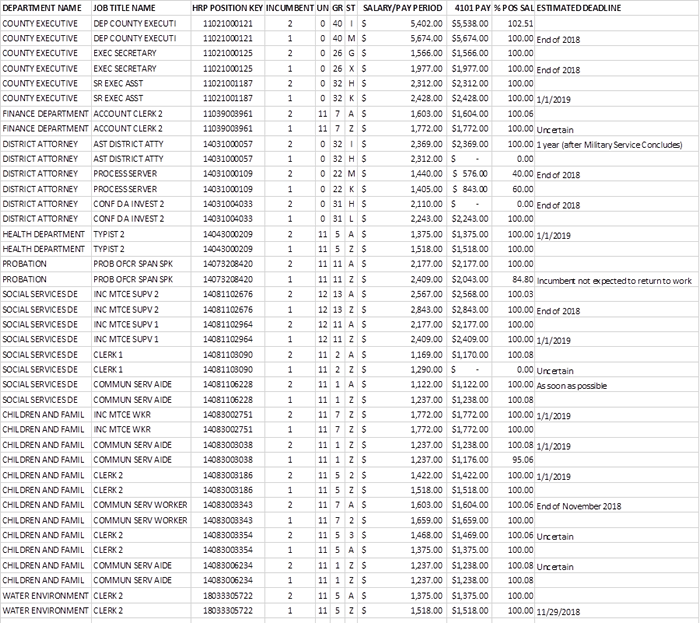
- The county executive positions and the WEP positions are new from the last report handed out
- Transition in county executive’s office; will not be double encumbered by the end of the year
- Most positions will not be double encumbered by the end of the year
- New ones will come on, others will come off, it is a fluid list – will continue to change from pay period to pay period
- Typically used for transitioning and training; sometimes there is a title that a department doesn’t have but needs – requested that title in budget process
Mr. Jordan said that a number of community services aide positions have been double encumbered for quite some time and question why. Mr. Morgan said that they don’t have the appropriate number of titles, and have to create some of those in the next budget cycle potentially. It is a commonly used title, as it is entry level with few qualifications, grade 1. The position is used as a utility player in the social services world. He said that he can look into it more. Mr. Jordan said that the purpose for this was to maintain control over these positions; the resolution that the legislature passed said that if a position was double encumbered beyond 90 days, there needs to be an explanation as to why, and the legislature would need to approve it. Some of these have been double encumbered for much more than 90 days. Mr. Morgan said that he attempted to bring resolutions over for every position that was over 90 days. Mr. May said that we need to figure out a way to connect that requirement with the department head. He does not think it should be Mr. Morgan that gives the rationale. He asked Mr. Morgan to connect that in the process. Mr. Jordan agreed that he thinks the department heads need to come forward with an explanation of why the positions are double encumbered for such a long period of time.
b. 3rd Quarter Forecast
Mr. Morgan distributed the report and pointed out the following:
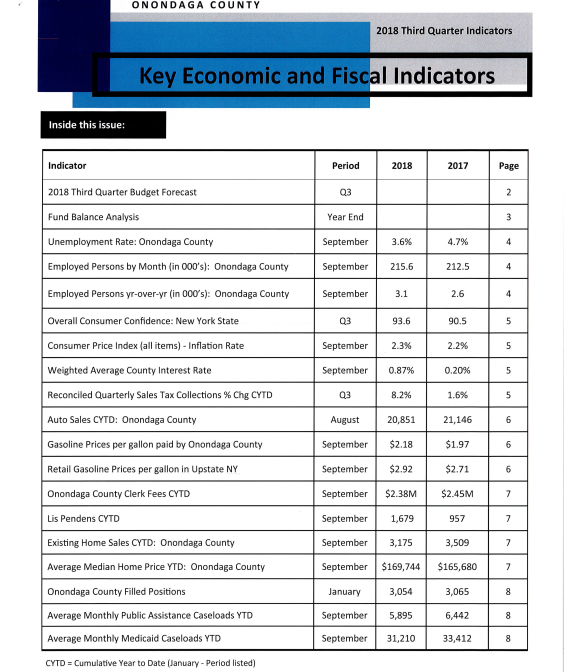
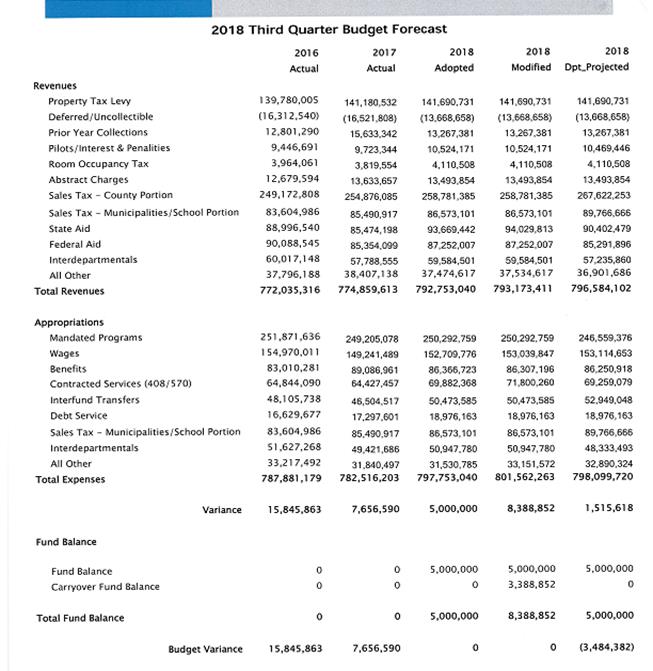
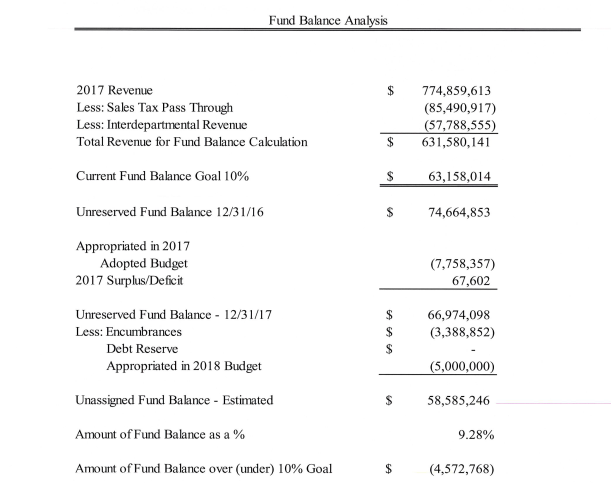
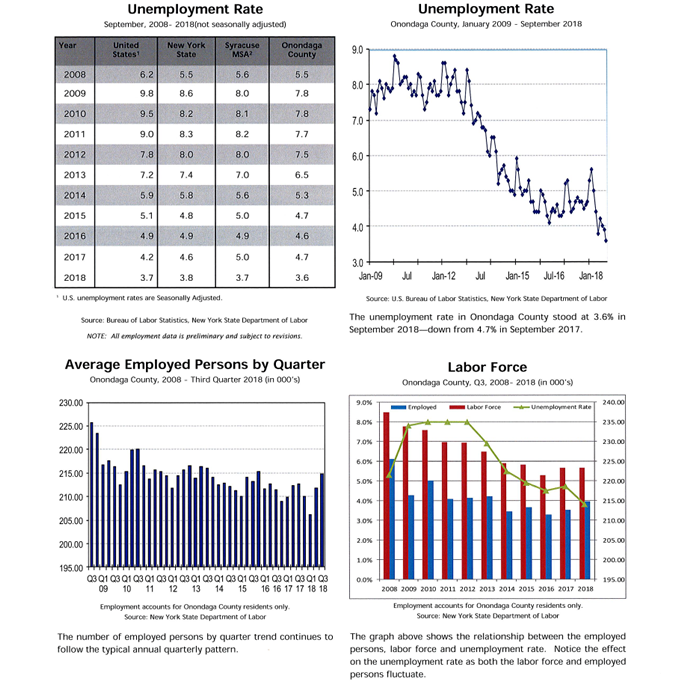
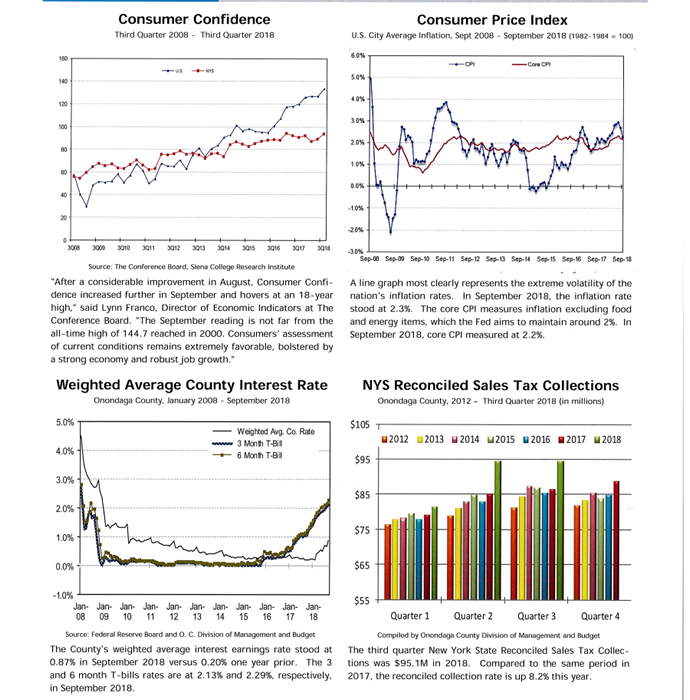

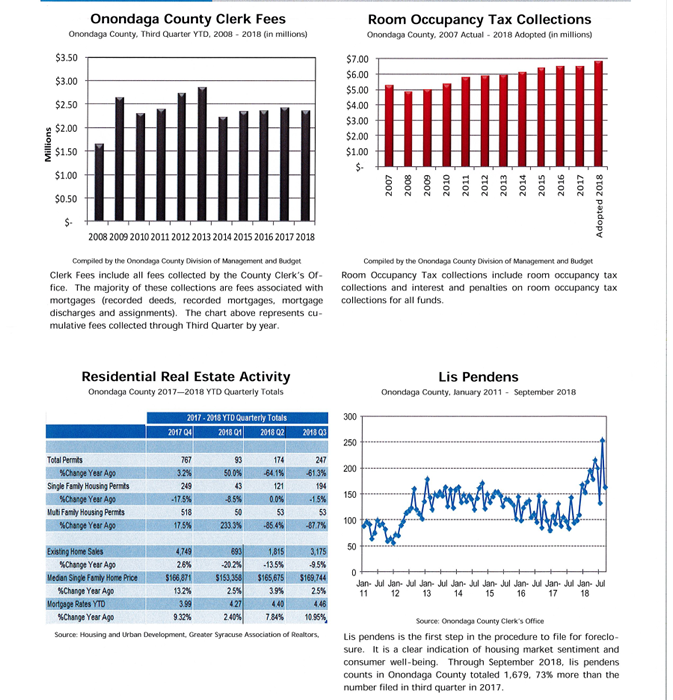
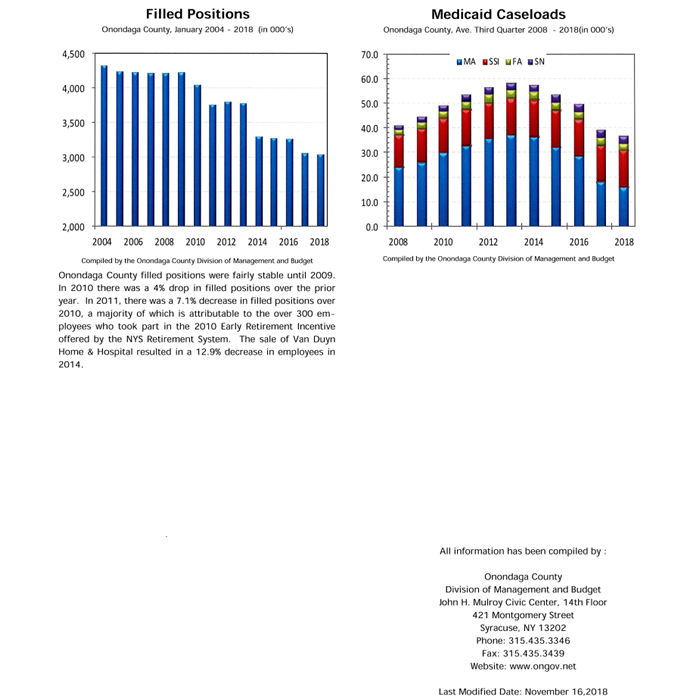
Page 1:
- Reconciled quarterly sales tax collection – the collections in Q3 this year compared to Q3 last year is 8.2% higher
- Cumulative growth in sales tax between this period in 2018 compared to 2017 is up 8.8% right now with 5 or 6 payments left to go.
- Sales tax is strong, continues to be strong, believes we will end considerably over budget for the year
Page 2:
-
Revenue/expenses projected to be short $1.5 million without using the planned use of $5 million of fund balance; at the point projection is to use $1.5 million out of fund balance
-
Variance on revenue side is sales tax – projecting $267 million as county share; budget is $258 million – assuming 5% growth this year; growing at almost 9% year over
-
Most likely won’t use any fund balance and will hopefully add to it
-
Most other categories are mainly within budget
-
Wages – tight – staff reductions in 2017 and 2018; departments are scrambling, but are holding the line to stay within salary accounts
Page 3 Fund Balance Analysis:
- Estimating the full amount of fund balance to be used because don’t know how the year will end
- Right now $4.5 million short of legislature’s fund balance goal; if we can end the year and not use fund balance – will be back at the goal; hopefully will add more and be above the 10% goal
Mr. May said that but for wages and internal costs through inter funds, we are doing pretty well on the expense side. Mr. Morgan said that actually expensing in 2016 were $787 million; now looking at $798 million; $11 million over 2 years is not too bad. In 2017, we lost 200 people to the retirement incentive; 2018 budget process was tough when departments were rolled back to 2016 spending levels.
Mrs. Ervin said that the bowlers contributed to the sales tax this year. Mr. Morgan said that is part of it, and a big part is gasoline prices. On a national level the economy is doing pretty well. There are prior years’ adjustments that happen with sales tax payments, and am looking into seeing if there is some retro to the positive, or if it just current year.
Mr. Jordan questioned how the state determines our contributions to the state retirement. Mr. Morgan said that it a percentage of salaries; the Comptroller’s office reports salaries and the state determines what the percentage will be. It is usually tied to the stock market and how they think the fund is going to grow. Mr. Jordan said that the state’s percentage is based upon what they think will happen. Mr. Morgan agreed – how they think it will grow and the payouts that we will have. Ms. Venditti said that the contribution is about 15% right now. Mr. Jordan asked if it projected that the percentage will go down next year. Mr. Morgan noted that at NYSAC’s finance school held every year they have said not to expect any huge decreases. It has been pretty flat for the last 2 years. He said that the things the county has done has helped; shaving head count saves on the bill.
Mr. Jordan asked if this based on salaries plus overtime. Mr. Maturo said that it does include overtime, but the more recent tiers cap overtime at the first $15,000. Tiers 1, 2, 3 includes whatever was earned in overtime. It was part of the issue with the Sheriff’s department, and earning a lot of overtime, that all goes into the average salary. In answer to Chair Cody, Mr. Maturo said that when the stock market crashed, we didn’t really see the spike until two years down the road. Overall this year, we are looking at $3 million in retirement billing, and some of this is the benefit of the stock market going back up. If the stock market stays where it is, we should see a favorable rate next year. He referred to Ms. Venditti’s comment about the rate being 15%, and explained that it depends on the tier and goes as high as 25% and as low as 8%. It is a blended rate.
Mr. Morgan noted that early retirement incentives are expensive to participate in. Last time the state required that the county could only fill half of the positions. It had to be tracked in case the state ever came in to look at it. It made sense, because something like that is offered to get higher paid employees off the rolls and only fill part of them. Mr. May said that it also freezes the liability; bringing people in at lesser tiers, which is a plus.
In answer to Mr. May, Ms. Venditti said that the requirement was that over two years there had to be a 50% savings. Mr. Morgan said that when the county offered its own retirement incentive, we held almost all of those positions open. A handful came back in, but departments gave up other expenditures in their budget.
Mr. Bush asked if a report is received from OCIDA regarding the amount of lost revenue on sales tax, mortgage recording tax, and property tax forgiveness, they give to their expansions. He said that he goes to their meetings and it seems like we are losing millions of dollars over the course of a period of time. Mr. Morgan said that there is a new GASB requirement that requires our financial statements to attempt to measure that. Mr. Maturo said the information is given to the Comptroller’s office by OCIDA and by SIDA. It is a requirement, and there is a footnote within the financial statements. Mr. Bush asked if that is public knowledge. Mr. Maturo said that it is. The information is in OCIDA’s financial statements, and then information is pulled out of there and into the county’s financial statements. In answer to Mr. Jordan, Mr. Maturo said that the information is in the CAFR; OCIDA is a component unit. Also, the taxes being forgiven are our sales tax, our mortgage tax, our property tax, and are require to report that.
In answer to Mr. May about things that need to be cleaned up or potential hotspots, Mr. Morgan said that in December some departments will be coming over to clean some things up. He agreed that it is all internal, and not huge numbers. As usual, a year-end authorization will be used for typical things, i.e. social services program, judgments and claims, or certiorari. At this point in time, he said he does not see anything out of the ordinary.
7. PERSONNEL: Brian Donnelly, Deputy County Executive
a. Amending the County Budget and Providing for Various Personnel Changes
-
A number of creates, abolishes, and modifications
-
Create 3 positions: Chief of Staff in Co. Executive Office, Deputy Director of Economic Development in Economic Development; an additional Director of Development and Office Planning in Facilities Management
-
Abolish 5 positions: Accounting Supervisor, Finance; Clerk II, Health; Programmer I, IT; Personnel Svcs Aide, Personnel; Stenographer II, WEP
-
Transferring funding from WEP to County Law Dept to fund an existing deputy county attorney 3 position – will focus on clean water initiatives and sewer issues at WEP through the Co. Law Dept.
Mr. May referred to the five abolishes, and said he was hoping to see more. At the same time, he realizes that it is a transitional time and we are shifting things around. It would be nice to clean up more as we move along, once there is clarity on direction. Mr. Donnelly agreed and said that more will be seen as they go through. Mr. Frateschi is working with the departments and looking at the different operations. He said that they will find additional positions to bring over.
Mrs. Ervin said that everything is internal, and nothing additional. Mr. May said that there are no new dollars. Mr. Donnelly agreed.
A motion was made by Mrs. Ervin, seconded by Mr. May, to approve this item. Passed unanimously; MOTION CARRIED.
A motion was made by Mrs. Ervin, seconded by Mr. Ryan, to adjourn the meeting at 10:08 a.m. Passed unanimously; MOTION CARRIED.
Respectfully submitted,

DEBORAH L. MATURO, Clerk
Onondaga County Legislature
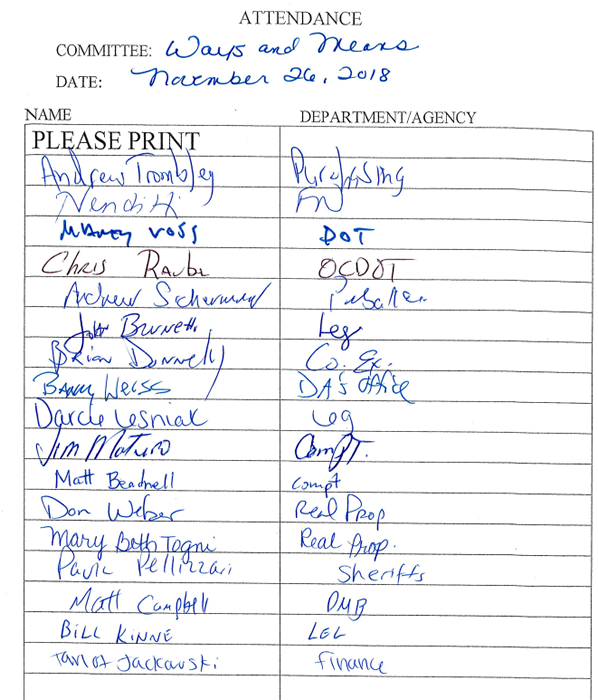
|





















































